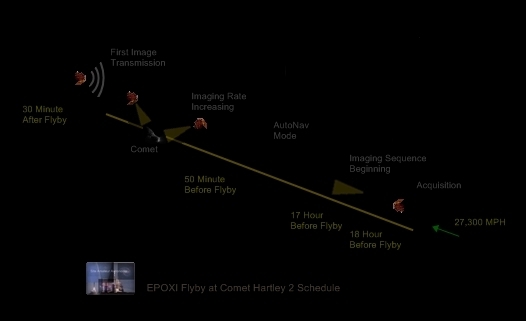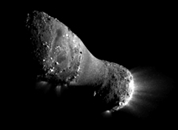
- - text and links as of last publication - -
 | click to a larger view of Comet Hartley 2 as seen during the EPOXI flyby in November 2010. picture site 'Amateur Astronomy' based on pictures courtesy NASA/JPL-Caltech/UMD |
The EPOXI spacecraft successfully imaged the nucleus of comet 103P/Hartley 2, or Hartley 2 on on Nov. 4,
2010 by around 6:59 a.m. PDT (9:59 a.m. EDT)! The spacecraft
came within about 435 miles (700 km) of the comet's nucleus at the time
of closest approach. Two imagers and one infrared instrument acquired data. Before the encounter with Hartley 2, the craft was closing at a rate of 27,300 mph (44,280 km/h), as one day away from the comet! It is only the fifth time in space history
that a comet nucleus has been imaged

 | click to a video of the EPOXI flyby at comet Hartley 2. video site 'Amateur Astronomy' based on a video courtesy NASA/JPL-Caltech/UMD/Brown University |
The imaging and science sequence proper began 18 hours -496,000 miles (798,000 km)- away when the craft locked its instruments on the comet and begin its encounter phase data collection. The comet then was still a mere point of light. A hour later the imaging sequence began with the frequency of image-taking increasing with closeness reaching a crescendo in the minutes surrounding approach. 50 minutes before closest approach, the spacecraft's onboard autopilot, or AutoNav Mode went active. With that mode on, the spacecraft receives attitude (pointing) instructions from its computer to help keep the comet's nucleus centered in spacecraft's imagers as any command sent from the Earth would have taken 75 seconds to scour the 23 millions miles (37 millions de km) separating the mission control from the mission. The AutoNav Mode works by having the spacecraft's imager look for the brightest light source in the sky excluding the Sun. That mode already had been used for the flyby at comet Tempel 1 by 2005 as that comet shape was providing one central point of light as 103P/Hartley 2 with its elongated shape should have had the Auto Nav to make the right decision on which of both bright source was to be used. All data were collected into spacecraft memory for later playback and the EPOXI team began receiving imagery from the spacecraft starting about 30 minutes after closest approach. NASA's Jet Propulsion Laboratory, a division of the California Institute of Technology, manages the EPOXI mission for NASA's Science Mission Directorate. The spacecraft was built for NASA by Ball Aerospace & Technologies Corp., in Boulder, Colo. (the accompanying video has been made from a 40-frame, NASA video clip taken with the mission's Medium-Resolution Instrument (credit NASA/JPL-Caltech/UMD/Brown University), beginning about 37 minutes before the time of closest approach at a distance of about 17,000 miles (27,350 km) and lasting until 30 minutes after closest approach at a distance of 13,800 miles (22,200 km); we have slowed frame rate)
With Sun to the right, EPOXI Medium-Resolution Instrument captured detailed views of comet 103P/Hartley 2 nucleus and flying under. Early observations show that comet Hartley 2 was active, with jets spewing material from the surface. Images reveal comet Hartley 2 is 100 times less large in volume than comet Tempel 1, with a dimension estimated 1.4 mile (2.2 km) long. The comet already was emitting jets before the flyby as the comet was to its closest to Earth since its discovery in 1986. The nucleus is higly elongated and rotates about itself about once every 18 hours. More revelations about Hartley 2 are expected as analysis continues. The EPOXI mission is a extension of the Deep Impact mission which had released a impactor at comet Tempel 1 by July 2005
 | click to a larger view of Comet Hartley 2 detailed, as seen during the EPOXI flyby in November 2010. picture site 'Amateur Astronomy' based a picture courtesy NASA/JPL-Caltech/UMD |
Further data, as analysed after flyby, are showing that Hartley 2's rough, or smooth terrain is responding differently to the action of solar heating. The smooth area of comet Hartley 2 looks and behaves like most of the surface of comet Tempel 1, with water evaporating below the surface and percolating out through the porous dust material. However, the rough areas of Hartley 2 is featuring carbon dioxide jets spraying out ice particles and surrounding space around nucleus literally with a snowstorm of tons of golf-ball to basketball-sized fluffy ice particles. It is still ill-known whether the differences in activity between the middle and ends of the comet are the result of how it formed some 4.5 billion years ago or are because of more recent evolutionary effects. Other first results of the passage show more details. As Hartley 2 rotates along a central axis it also rolls around its long axis. Both rough edges of the surface are dotted with rocky spires reaching 230 feet high as the comet is spewing more water than any other comet of its size. The activity of the comet, like a dozen others, is generated by frozen underground carbon dioxide sublimizing and dragging water with. Astronomers are not sure whether both sides of Hartley 2 are connected by solid rock as the outer layer there is several tens of yards thick and a loose aggregate that slided from the ends. Those ends are dotted with spires and rocky blocks as, despite in a active period close to Sun, it is lacking pits and holes seen in other comets. The activity at the surface looks like material gets built up before collapsing in a sedimentary environment. The smooth waist puts out more water than the ends, which seem to outgas carbon dioxide only. Pure, fine-grained ice crystals, generally, aggregate in fluffy chunks as big as basketballs
Cometary jets have been analysed to spew out ice and carbon dioxide from one end of comet Hartley-2, while water vapor gets are released from the middle region. A third type of ice might also have been released, like one made from ethane. The differences suggest that the comet's core is made of at least two different ices. Ices in Hartley-2 further are mostly made of water, along with traces of many other types of molecules. This is in addition to the plentiful carbon dioxide already detected in the comet in 1997. What surprised the researchers was that, as the amount of water went up, so did the amounts of the other gases. And as the amount of water went down, the others did, too, a singularity never seen before. Icy grains are being dragged into the coma too as in other comets, waper appear to be converted into gas as soon as below or at the surface. The phenomenon at Hartley-2 might be due to that carbon dioxyde serves like a glue to ice particles and that, when evaporating, it takes away chunks of ice. Generally, a composition of a comet's core might reside into that compounds associate in varied ways
Recentest studies still consider Hartley 2 a 'hyperactive' comet powered by frozen carbon dioxide or dry ice deep under the surface jetting off the comet and dragging water ice with it as the water released in waist as vapor with very little carbon dioxide. The latter findings indicate that material in the waist likely came off the ends of the comet and was redeposited. Astronomers know at least a dozen other comets that also are relatively high in activity for their size and which are probably driven also by carbon dioxide or carbon monoxide, potentially representing a separate class of hyperactive comets, or they could be a continuum in comet activity extending from Hartley 2-like comets to much less active, usual and more common comets. Hartley 2 has been seen spinning around one axis, but also tumbling around a different axis as the glittering blocks dotting comet's ends can reach approximately 165 feet (50 meters) high and 260 feet (80 meters) wide and two to three times more reflective than the surface average. When Hartley 2 passing by the Sun as observed by the NEOWISE mission in 2011, it was seen leaving a pebbly trail with golf ball-sized chunks surviving farther away from the comet than previously known as the comet also was still actively ejecting carbon dioxide gas at a distance of 2.3 astronomical units from the Sun, which is farther away than where EPOXI detected carbon dioxide jets streaming from the comet. Hartley 2 was further found a really unusual comet with a drastic change from one close pass by the Sun to the next. The rate of water generation being so much higher in 1997 implies that the ice fragmentation was even more severe then. This is of importance as comets eventually 'dry up' and become less active with repeated passes through the inner solar system. Astronomers still don't know if this one had odd behaviors or some different kind of composition
Website Manager: G. Guichard, site 'Amateur Astronomy,' http://stars5.6te.net. Page Editor: G. Guichard. last edited: 9/5/2011. contact us at ggwebsites@outlook.com